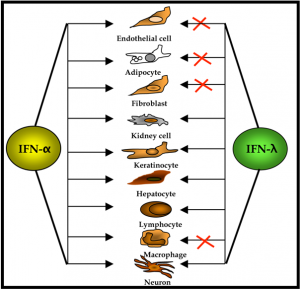 Hosts: Vincent Racaniello, Dickson Despommier, Rich Condit, and Kathy Spindler
Hosts: Vincent Racaniello, Dickson Despommier, Rich Condit, and Kathy Spindler
The TWiVome dissect the finding that interferon lambda alleles predict the outcome of hepatitis C virus infection.
Click arrow to play
Download TWiV 273 (75 MB .mp3, 103 min)
Subscribe (free): iTunes, RSS, email
Links for this episode
- Interferon lambda and HCV outcome (Cell Host Micr)
- Laser capture microdissection (Wikipedia)
- HCV dependent fluorescent reporter (Nat Biotech)
- Bats and viruses (PLoS Path)
- White nose syndrome (PLoS Path)
- Mouse phenome database
- Image credit
- Letters read on TWiV 273
Weekly Science Picks
Rich – Think like a scientist (one, two); Science controversies
Dickson – Visualization challenge 2013
Vincent – Orphan Black
Kathy – Alberta worm invasion project
Listener Pick of the Week
Timothy – How do vaccines cause autism?
Anne – Luke Jerram’s glass viruses
Jim – NLM Communications Engineering Branch
Steve – Synapse by synapse
Jacob – Tiny technology creates a buzz
Send your virology questions and comments (email or mp3 file) to [email protected]


Dear TWIV,
Wow. You reviewed our paper on your show! Thank you! Dickson was right! I was yelling at my iPhone as I listened but it had to be a very soft yell as my wife was sleeping next to me. HA! You asked many excellent questions during the podcast, I thought I’d try to answer them here. The backstory to the paper is complicated…
Yes…This paper is huge and it took a long time to come out. I’m a molecular virologist and had to learn laser capture, RNA amplification, microarray and the bioinformatics as the project developed. Even though I’d rather be plaque-ing, the science has forced me to wear many hats. Additionally, the fetal livers that we purchase have a random IL28B genotype. Thus, in order to obtain a large enough number of each genotype, we obtained lots of livers over a 2+ year period, rapidly genotyped the cells and only performed microarray on the genotypes that we needed to finish out the work. Dickson brought up the potential use of primary adult hepatocytes. These cells are very finicky, hard to come by for free and if purchased very expensive (~$800 for 5 million cells). They also do not divide in culture (i.e. what you buy is what you have to work with) and normally have to be co-cultured with a non-parenchymal cell to maintain hepatocyte function for longer periods of time. Nevertheless, these are experiments will be done in the future so stay tuned.
Kathy asked about the nature of the HCV dependent fluorescent reporter and Vincent was correct. The reporter is a fusion of the C-terminus of IPS-1 (aka MAVS etc.) targeted by HCV coupled with a nuclear localized RFP. After cleavage by the viral protease on the surface of cytoplasmic organelles like mitochondria, the RFP portion is free to traffic to the nucleus. Rich also was unclear about the nature of the “mock” samples. Mock cells were transduced with the lentivirus expressing the reporter. We did microarrays comparing primary hepatocytes expressing the reporter to lenti-naieve hepatocytes and didn’t see much difference in their transcriptomes and nothing really in innate immunity. This doesn’t mean that things are not happening below the limit of our detection. Unfortunately, we are currently stuck with the reporter in order to carry out these studies and try to address it’s use with lots of controls.
I’ve got lots of great visuals and movies to explain this technique. FYI. If you have any more questions, please don’t hesitate to ask.
Thanks again for discussion our paper. It was great to hear people from outside of the HCV community enthusiastically discuss our work. Virology is awesome right? It doesn’t matter what color it might be.
Tim